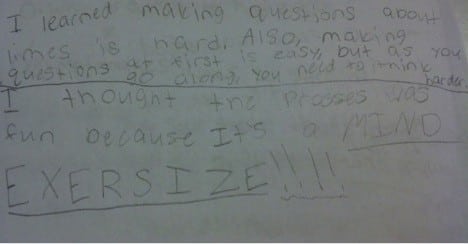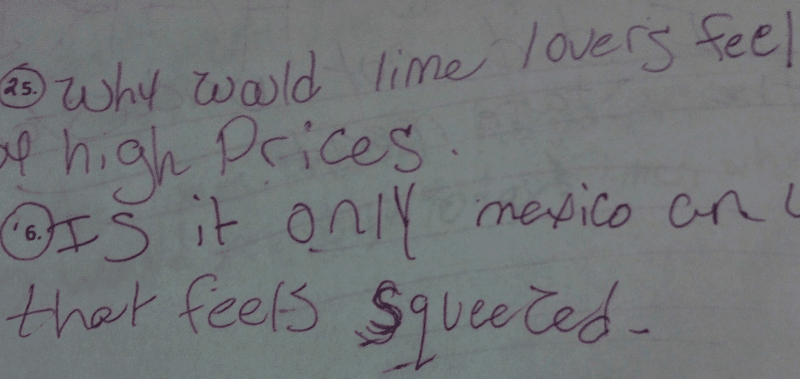Joshua Beer discovered the Question Formulation Technique (QFT) while searching for more ways to integrate questions into his classroom. A middle school social studies teacher, Beer greatly encourages and promotes questions in his classroom and wanted to do more to get his students engaged in asking their own questions. Beer has been using the QFT for the last three years and both he and his students have greatly benefited.
While reading the article in the Harvard Education Letter, I knew immediately that the QFT was a technique that I could institute in my classroom the very next day. The QFT has been a regular feature in all of my classes and has truly expanded my teaching and my approach and use of questions in my classroom as well as my students’ ability and desire to produce questions.  Over the last three years, I have modified and tweaked the QFT and found that it can be utilized for any topic for any grade level. The simple steps, such as identifying open and closed questions and prioritizing questions, were ones that I was able implement without difficulty. However, it was the ease in which students took to the idea of coming up with questions that was such a pleasant surprise. Students are naturally curious and once the rules of the QFT were explained they quickly took to the task of formulating their own questions. Like any activity the more you work at it, and work in a deliberate manner, the better you become at the activity.
Over the last three years, I have modified and tweaked the QFT and found that it can be utilized for any topic for any grade level. The simple steps, such as identifying open and closed questions and prioritizing questions, were ones that I was able implement without difficulty. However, it was the ease in which students took to the idea of coming up with questions that was such a pleasant surprise. Students are naturally curious and once the rules of the QFT were explained they quickly took to the task of formulating their own questions. Like any activity the more you work at it, and work in a deliberate manner, the better you become at the activity.
The QFT is inherently easy to use and implement and I have been getting better and better at finding the most optimal use of the QFT. For the teacher the most challenging task is to come up with an appropriate QFocus though it might be the most enjoyable. The better the QFocus the better the chance students will come up with great questions. When I am creating a QFocus I try to envision the best possible generator of student questions. Does this QFocus relate to the topic, is it fairly easy to comprehend, will it elicit different thoughts and emotions within the student? For example I have used everything from political cartoons like Benjamin Franklin’s “Join or Die” to provocative statements such as “Imperialism is an acceptable policy for the United States” to images like Washington crossing the Delaware River to quotes from articles like this NPR headline “In Mexico and U.S., lime lovers feel squeezed by high prices”. Once the QFocus has been developed and given to the students I am continually amazed by the insightful questions students produce. As I continue to use and better understand the ways in which the QFT can be implemented I have become more adept at creating high quality QFoci. Not only did I become better at creating a quality QFocus but my understanding and sense for when and how to use the QFT became sharper.

Student questions – 5th Grade Social Studies Class In my social studies classes we have implemented the QFT at every grade level, 5th through 8th and for countless topics in Geography, World History and US History. The QFT can be applied to any subject and social studies is a discipline where questions are an essential component of learning. For the QFT to be as effective as possible, students must feel safe, and that their opinions and questions are respected. I also believe that the QFT helps to strengthen and build this environment. When students are sharing their questions within their group or class this builds a culture of acceptance and respect for what each and every student brings to the class. Another important aspect of using the QFT is the engagement and empowerment that students receive from creating their own questions. In a typical class the questions that are raised are ones that are teacher or textbook created. However, the QFT allows students to create their own questions which increases student engagement and gives them a natural impetus to find the answer.
Student reflection – 5th Grade Social Studies Class Every new school year brings in a new set of 5th grade students allows me to always have a new batch of students to introduce the QFT to but also to continue working on and improving how to use the QFT with my veteran students. On the second day of this new school year I used the QFT in all of my classes with the QFocus “Learning”. With the new 5th grade I needed to do a full introduction to the QFT but with my older students they only needed a brief review. The experiences my students have gained while working with the QFT has helped transform my students and classroom. The attitude and the disposition to ask questions has led to deeper conversations, more insightful observations and fostered a classroom where questions are valued, honored and encouraged. As my students become more comfortable with the QFT and I become more adept at the art and science of using the QFT the learning possibilities for my students are endless. As the quote from a new 7th grader below illustrates – we have so much more to learn. And that is truly exciting.

